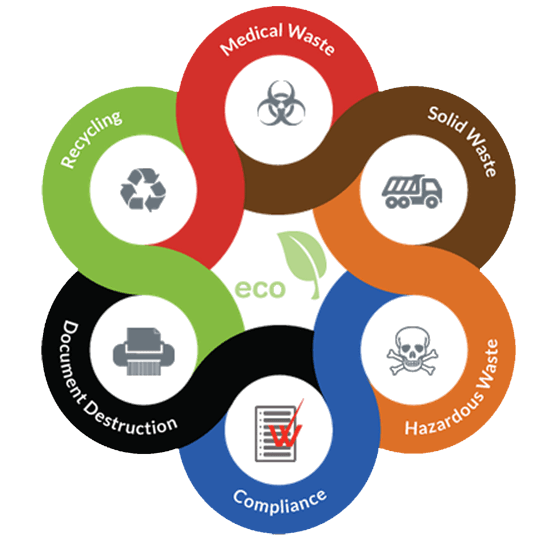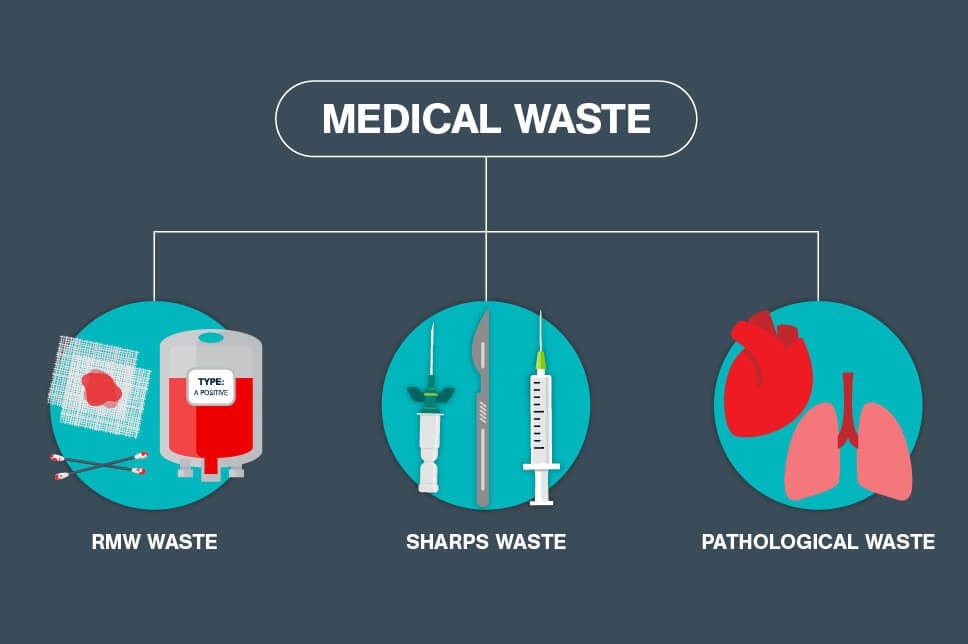Efficient and Accountable Medical Waste Removal: Protecting Individuals and the Earth
Finest Practices for Medical Waste Monitoring
Medical waste administration is a crucial facet of healthcare facilities' procedures to guarantee the security of people, team, and the environment. Carrying out ideal techniques in clinical waste monitoring is important to lessen the threats connected with harmful waste. This consists of proper partition and classification of waste, guaranteeing its secure storage space and labeling, sticking to regulative standards, and using efficient disposal techniques. By complying with these finest techniques, health care centers can decrease the capacity for infections, injuries, and pollution brought on by improper handling and disposal of medical waste. This intro intends to provide an introduction of the value of ideal techniques for clinical waste monitoring and the succeeding areas will certainly delve into each technique thoroughly.
Segregation and Categorization
In the area of clinical waste management, correct segregation and categorization are crucial methods for guaranteeing the efficient and secure disposal of healthcare-related materials. Clinical waste is generated from numerous sources, consisting of healthcare facilities, clinics, research laboratories, and other healthcare centers. It consists of a broad range of items, such as needles, syringes, bandages, handwear covers, and pharmaceutical waste.
Segregation includes the methodical splitting up of various kinds of clinical waste based on their features and prospective risks. This procedure helps to stop cross-contamination and ensures that each type of waste is handled properly. Sharps waste, such as blades and needles, must be positioned in puncture-resistant containers to prevent injuries and the spread of contagious conditions. In a similar way, infectious waste, such as blood-soaked bandages or cultures, must be set apart and treated individually to lessen the threat of spreading out virus.
Categorization is the process of classifying medical waste into different classifications based on its prospective dangers. WasteX Medical Waste Disposal. These classifications may include infectious waste, contaminated materials, pharmaceutical waste, and general waste. By classifying waste, medical care centers can establish the ideal disposal approaches and make certain compliance with local laws and standards
Appropriate segregation and classification of medical waste not only protect the health and wellness of health care workers and the basic public however also add to the general effectiveness and effectiveness of waste management. It lowers the danger of accidents, minimizes ecological effects, and advertises accountable waste disposal techniques.
Appropriate Storage Space and Labeling
To make sure the efficient and secure disposal of medical waste, medical care facilities need to comply with appropriate storage and labeling methods. Correct storage and labeling play an essential duty in maintaining the honesty of medical waste administration systems and securing the health and wellness and safety and security of healthcare employees, patients, and the public.
When it comes to storage, it is important to have marked areas particularly created for various kinds of medical waste. These locations need to be protected, well-ventilated, and furnished with ideal containers that meet regulative requirements. Partition and categorization of waste ought to likewise be thought about to avoid cross-contamination and prospective threats.
Furthermore, correct labeling is vital for effective waste administration. Each container must be plainly classified with the appropriate symbols, color-coding, and info regarding the waste it consists of. Tags need to consist of information such as the sort of waste, date of collection, and the name of the generator. This makes sure that all people handling the waste can easily determine and manage it correctly.
Regular monitoring and inspection of storage space locations and containers are necessary to recognize any type of problems or violations. Staff needs to be educated on appropriate storage and labeling practices, stressing the importance of conformity with procedures and policies.
Safe Transportation and Handling
Ensuring the correct and safe transport and handling of medical waste is important for maintaining the honesty of waste administration systems and securing the health and safety of all involved. Clinical waste, which consists of items infected with contagious materials, pharmaceuticals, and various other harmful compounds, should be carried in a way that avoids leaks, spills, and possible contamination.
It is important to utilize leak-proof and puncture-resistant containers that are particularly designed for clinical waste. In addition, waste ought to be segregated based on its nature and type to avoid cross-contamination.
During transportation, it is essential to guarantee that waste containers are safely secured and saved in a secure fashion. Vehicles used for delivering clinical waste needs to be geared up with suitable security attributes, such as spill control systems, to decrease the threat of any spills or leaks (medical waste disposal). Motorists must get training on correct handling and emergency situation feedback treatments to effectively attend to any kind of unexpected occurrences
Additionally, the transport and handling of clinical waste need to abide by all appropriate guidelines and standards established forth by local, state, and federal authorities. Routine examinations and audits should be carried out to assess conformity and identify any kind of areas for enhancement.

Compliance With Regulatory Guidelines
Preserving conformity with governing standards is important for efficient clinical waste monitoring. These guidelines are established to shield public wellness and the setting by making certain that clinical waste is effectively managed, dealt with, and disposed of. medical waste removal. Compliance with regulatory guidelines aids to avoid the spread of transmittable illness, minimize possible risks, and reduce the total effect of medical waste on the setting
To achieve compliance, medical care centers have to remain notified about the specific laws regulating medical waste monitoring in their jurisdiction. These regulations might vary from country to nation, and even within different states or areas. It is vital for health care facilities to have a comprehensive understanding of these standards and to apply proper techniques and protocols to ensure conformity.
One secret element of conformity is the appropriate segregation and labeling of various kinds of clinical waste. This consists of separating sharps from various other waste, as well as categorizing waste based upon its potential dangers. Healthcare centers must also ensure that medical waste is saved in suitable containers which these containers are appropriately classified and sealed.
In addition, compliance with regulative standards requires health care centers to develop proper training and education programs for team members entailed in clinical waste administration - WasteX Medical Waste Disposal. This consists of giving training on waste segregation, managing, and disposal treatments, along with the appropriate use personal protective equipment
Regular surveillance and audits are likewise vital to make sure continuous compliance with regulatory standards. This entails carrying out routine evaluations of waste storage locations, recording waste administration procedures, and keeping documents of waste disposal.
Effective Disposal Methods
Medical care facilities should employ effective disposal approaches for appropriate administration of medical waste - WasteX Medical Waste Disposal. Incorrect disposal of medical waste can position serious wellness and environmental risks. There are a number of methods that can be made use of to properly dispose of clinical waste, making certain the security of healthcare workers, individuals, and the public
One typically used approach is incineration. Incinerators can safely melt clinical waste at heats, decreasing the have a peek at this site volume and damaging any type of potentially hazardous pathogens. Incineration can be expensive and may release damaging contaminants into the air if not properly managed.
An additional approach is autoclaving, which entails subjecting the waste to high-pressure steam. This process kills microorganisms, viruses, and various other bacteria, providing the waste risk-free for disposal in routine waste streams. Autoclaving is a environmentally friendly and reliable method, yet it calls for specific devices and skilled personnel.
Chemical disinfection is additionally made use of in some cases, where liquid chemicals are put on the waste to decontaminate it. This technique is less typically used as a result of problems regarding the effectiveness of chemical sanitation and the potential for chemical deposits to pollute the setting.
Along with these methods, health care facilities must additionally execute appropriate partition, packaging, and labeling of clinical waste to ensure its safe handling and disposal. Routine training and education and learning of staff on correct waste management methods are essential to preserving effective disposal techniques.
Verdict

Clinical waste administration is an important aspect of health care centers' operations to ensure the security of individuals, personnel, and the environment. Applying ideal methods in medical waste monitoring is vital to minimize the threats associated with unsafe waste. These classifications might include infectious waste, harmful waste, pharmaceutical waste, and general waste.In final thought, implementing finest practices for clinical waste monitoring is vital for guaranteeing the safety and security of healthcare employees, patients, and the setting. By correctly classifying and segregating waste, keeping and classifying it correctly, making sure secure transportation and handling, abiding with regulatory standards, and employing efficient disposal approaches, healthcare centers can properly manage and lessen the risks connected with clinical waste.